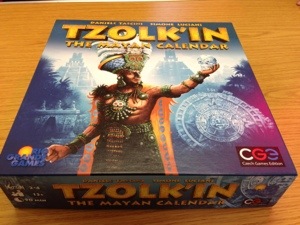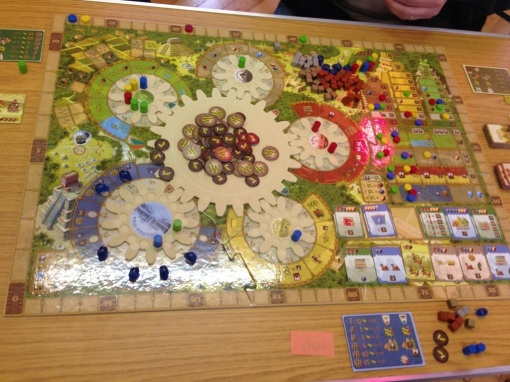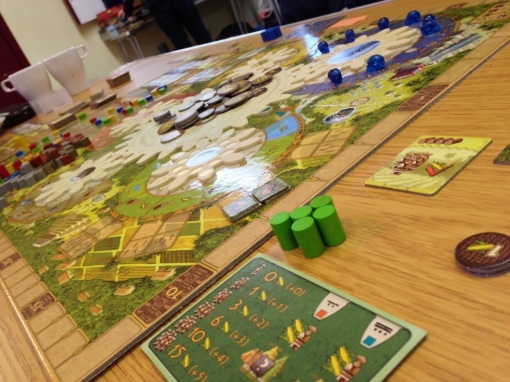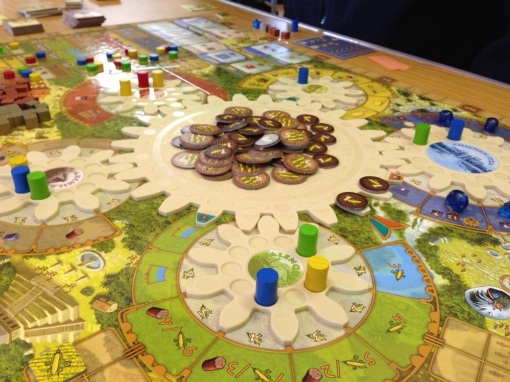Tzolk’in: The Mayan Calendar
Age: 12+
Players: 2-4 players
Duration: 90 minutes
As with the recent SdJ Kennerspiel winner, Village, designers and publishers appear to be putting more thought in how to keep the worker placement mechanism fresh at a time when I’m reading more posts/articles on people becoming bored of this mechanic.
Whereas Village sees meeples dying off; one of Essen’s most eagerly awaited Euros, Tzolk’in: The Mayan Calendar, has them taking a ride on cogs which form the main focus of an otherwise already busy board.
In essence, each of the smaller cogs represent a different location, and each location allows the workers different benefits. These benefits come into play when a worker is removed – rather than added to the board. So, taking a worker from Palenque may result in corn (currency) or wood.
Removing a worker from Chichen Itza on the other hand, allows you to donate a crystal skull which pleases the Gods and allows you to ascend their temple as well as gain instant VIPs. There are three other of the small cogs each offering a variety of options such as building monuments and buildings, or progressing up a technology track which brings added benefits to chosen actions, for example.
There are three types of resource; gold, wood and stone. Corn is multi-functional (currency/food).
There are costs associated with each action (in most cases). When placing a worker the further around the cog you are, the more expensive it is to do so. Also, you need to remember that placing multiple workers in a turn will cost more: Not only do you pay for the spaces you lay at, you pay an increasing additional cost. This is 0 for 1 worker, 1 for two, 3 for three, 6 for four, 10 for five and 15 for six workers. There is a starting player space which costs 0 to place at, but of course, only one person can occupy that at a time.
So, on a turn, you simply have two main choices: are you placing or removing workers? As placing workers generally has a corn cost attached, you may find you become short of cash from time to time. At this time of crisis, you can make a beg for corn prior to your turn. This will bring your corn tally up to 3, but will anger the Gods! The price you pay is a demotion in a temple of your choice (temples bring resources and VIPs at various points in the game). In Palenque, you can also anger the Gods if you find corn is not available yet so burn forests to get to it. Again, the same penalty befalls you! Woe be to anyone angering those deities!
The Gears
What about the gears then? Well, they aren’t just a gimmick – they are an integral part of the game. After each player has a turn, the day ends and a new one begins. The wheels of time turn, quite literally. One ‘click’ of the larger central cog sees the dawning of a new day.
Each worker already on a cog thus find themselves one more spot further than they were. This is usually to a more lucrative space and at no additional cost. Be warned though: spend too long on a cog and a worker may get bumped off and will have wasted many days’ worth of work! Timing is therefore very important. Jump off too early and only minimal rewards are gained. Leave it too long and others are progressing in the meantime and you run the risk of falling off; however, the rewards can be large.
With this, a new round starts. If no-one took the 0 start player action space then the current player begins the new round. However, if any player did use that action, then they begin the round (unless they already held the token – in this instance it passes to the next player). They also take any accumulated corn which builds up on days where no-one took that action. Finally, they have the chance to speed up time and progress two days instead of one, provided they haven’t done so already.
Feeding Days
Each quarter-turn of the cog results in a feeding day. You must pay 2 corn for each worker in play (initially 3 but max of 6). There are buildings which can help, but if you can’t feed a worker it’s three VIPs down the track for each.
There are benefits on feeding day too though. At 1/4 and 3/4 stages you receive resources printed on various steps up each temple in which you’ve progressed. At the halfway and end of game, instead you receive VIPs based on where you’re placed in each temple, with a bonus for those highest up the top.
I won’t go into the benefits of each of the buildings or monuments here. But, like the cards in Stone Age, some bring instant VIPs, resources or upgrades; whereas others are for end-game benefits such as most brown buildings built. Also, one half-turn of the wheel is considered Age 1, and the second half is Age 2. Any buildings left from the first age get replaced with new buildings in the second age.
Game end
The game ends at the end of one full revolution of the central cog (ie after 4 food days). Temple scoring occurs as described before. Any leftover resources are converted to corn and 4 corn equate to one VIP. Crystal skulls can also be converted at 3 VIPs each. Finally, monument points are calculated and the winner determined.
Game Play
I took part in a four player game at the Pasteboard and Plastic convention in Saltdean, UK, on Saturday 10th November. With none of us having played before, the rules took some going through before we were ready to begin.
We each took our 4 starting tiles and then the resources printed upon the two we liked the most. Some of us had a lot of corn whereas others had other benefits like starting technologies. Being the first game we weren’t sure what to go for really!
The game itself flowed very nicely. There was the usual conundrum of which of the many options to do for the best. Do you put all workers out? Some? Do you take them all back? Some? Do you go for resources for building, or for technology to help in the long-game?
Then, at the heart of it all, we have this cog which means that workers placed can gain better rewards, but what to do in the meantime? After all, you have to take something off or put something on, so they can’t just all ride along to greater things!
There appeared to be a bit of scope for AP, but it was more other distractions such as a prize raffle, rules lookup, loo breaks and essential coffee refills which slowed things down! I don’t suggest that 90 minutes is unachievable at all, but the game did last longer for our first turn. However, for me, it was all great fun and I am already looking forward to my next game.
With many options, random buildings/monuments/starting tiles, along with the fun factor, there is great scope for replayability. For me, the novelty of the dying characters in Village wore off pretty quick and I traded the game, whereas at the moment, I can see this being a game which stays firmly in the collection for a good few years, if not ever!
Points of note
1) Our Czech Games Edition pre-ordered Essen version came with a sticker on the front advising that a slight adjustment needs to be made to the board. In the haste of unwrapping and putting it together, the excitement meant we applied stickers to the cogs. This meant we couldn’t make the adjustments to the cog holes as the website referred to suggested. We are finding our cogs stick a little at times, but do think they will ease up over time, so are not overly worried.
2) 2/3 player games. These see the non-played workers placed on the board as ‘blockers’ – although I have yet to play a two-player, I’m sure this will work well. I will post back to let you all know!




